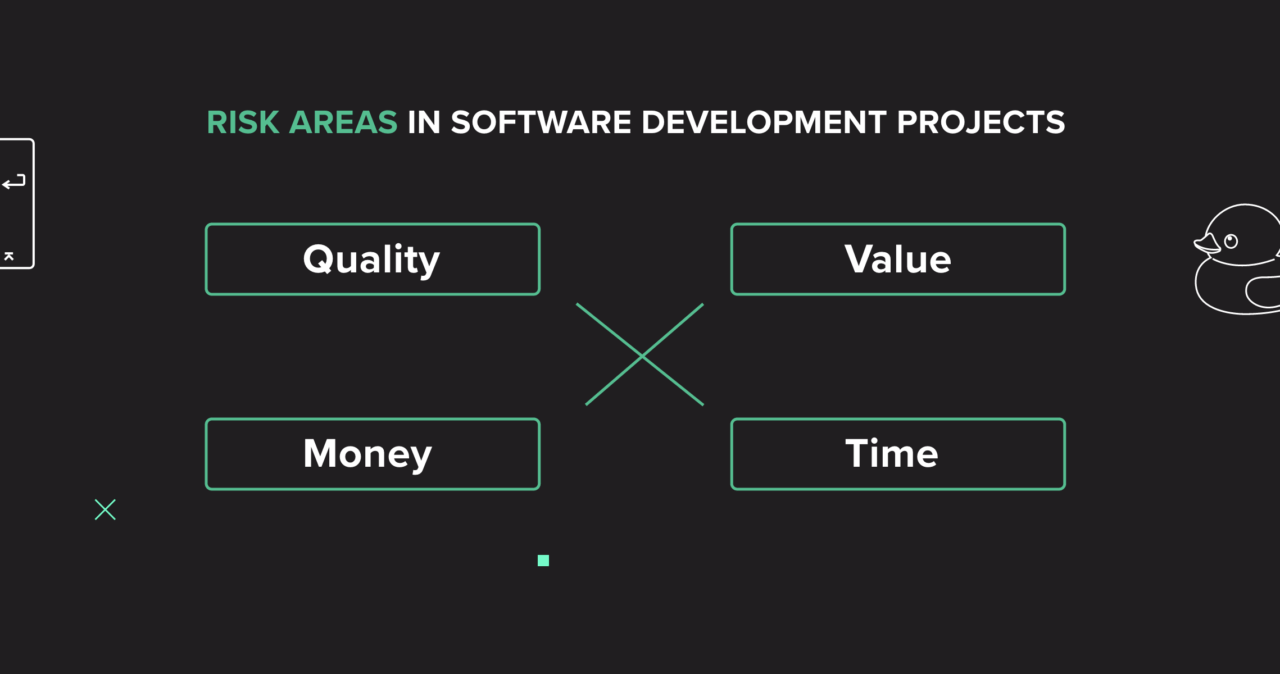How does agile reduce the risk of failure in software development projects?
They say no risk, no fun… While this saying may not be true in the area of software development projects, we must accept the fact that risk cannot be avoided. Therefore, it’s better to know the enemy and use the best weapon. It just so happens that the most effective way to manage risk is the agile methodology
In this article, you will learn why agile methodology, is the best possible project’s protection against failure. Like nothing in the world, it is a cure-all that gives 100% certainty, but the properly applied agile principle keeps the project risk at an understandable and „safe” level.
Articles content
1. Agile meaning and its relation to risk
2. Software projects’ risk areas
3. Agile ways for risk managing
4. Summary thought about the risk
Let’s start with a short introduction about what agile is and how the methodology qualities favor risk management.
What is agile about and how does it keep the risk away
Agile methodology, per definition, is about the skill of acting quickly. To make it possible, the work must be performed in short cycles. Agile teams deliver a working element of the product, for example, some specific functionality, at the end of each short-term iteration. The produced element needs feedback so the team knows what must be improved. Therefore, to provide constructive feedback, open communication and transparency are crucial.
These three aspects: delivery of working elements in short cycles; feedback loops; and transparent collaboration between people, are the core of risk management in software development. All of them create chances for the risk to be recognized as soon as possible. And the clue for risk management is to identify the risk and decide how to handle it.
Admittedly, the topic of risk management while running a software development project is vast. Risk factors are various, and each of them can be analyzed separately. Agile, however, has responses to most risks. Let’s examine more carefully the risks and the weapons Agile offers.
Common software project risks
Low quality
Delivering a high-quality product is a key factor that project teams have to take care of on a regular basis. A well-built product is the sum of its elements—carefully built and secured. What then impacts the product’s quality? Mostly, it’s the insufficient code quality. Factors having an impact on the quality of the code may vary, but the most common are:
unclear requirements,
too tight deadlines,
and, of course, technical risks, causing technical debt.
What is exactly technical debt? A piece of code that reduces the agility of a software project. It happens as a result of using timesaver methods when creating code to achieve the result faster.
In the long term, technical debt always comes to the surface and causes troubles, for instance, related to security. A correctly applied agile methodology, however, secures the code quality.

Lack of value
Problems with quality are also associated with the lack of a product’s value. Does the delivered product meet the market’s and audience’s needs?
Building a product users don’t need because it doesn’t resolve their problems is a waste of money and a direct way to its failure. If so, does the low business value mean that the product is lacking something? Possibly, but not necessarily, because very often software products are overloaded with features. And the statistics are pitiless – consumers don’t use over 50% of the apps’ features. They simply choose the most valuable ones.
Still, the client pays for each feature produced, and creating a product with many features means more money spent. If these functionalities are not used afterward because they have little value for the user, the business value is lost and money has been wasted.
Too high cost
It is not easy to estimate precisely how much a software product will cost, especially at the project’s beginning. Therefore, the risk of costs exceeding initial estimations, is relatively high, and managing this type of risk can be challenging.
This is why setting priorities, and planning the work step-by-step is a crucial part that allows for possibly accurate estimations in agile projects (which can be adjusted to be more accurate with every iteration.)
Missed deadlines
Another risk software development projects have to manage is the delayed time of delivery. There are various reasons for time risk to occur, but more disturbing, are the effects that delayed delivery can cause. Depending on a project, the late launch may mean the lost of money, and chances for company to grow, or paying some kind of penalties.
What is the agile approach to risk?
Compared to traditional projects, the agile approach protects software projects with a few effective techniques. The risk management techniques that agile uses affect all the previously mentioned project risks. By applying one type of agile risk management method, we can regulate several potential risks at the time.
Prioritization
Agile and its frameworks take care of producing the product’s basis—its greatest and unique value—first. This way, we can be sure that we have enough money for the most important elements. Having an already implemented product’s core (and if the budget allows), we can start to produce additional features. By setting this „safe direction,” Agile development secures financial risk as it allows the team to produce additional features only after creating the basis constituting the product value.
To build a valuable product’s elements first, the agile teams need to know which requirements create the value. This is why the prioritization of the requirements is the crucial analysis that the agile project teams have to conduct. Agile methodologies like Scrum or Kanban have several methods at their disposal, in the form of artifacts and events, that ensure the proper level of prioritization and, as a result, risk reduction.
Backlog
A list of tasks in the form of user stories The Backlog sets out the requirements for the product and its functionality. It usually contains many elements and ideas, but not all of them will be implemented. However, they are all related to the product’s and users’ needs.
The team—made up of experts and clients—has to carry out the backlog’s prioritization. This is to define the product’s essence and to rank the importance of its elements. Setting priorities helps with implementing the essential functions first. This, in turn, helps to reduce the risk of project development with no value for the user or business. Backlog prioritization allows the agile teams to build the essence of the product within the budget and on time.
As working in agile is an iterative process, the backlog priorities can change over time. The backlog’s re-prioritization takes place continuously, as the agile development team discovers more details or new information about the project. This makes changes to requirements, which are a normal and frequent occurrence in software projects, safer. Risks related to backlog changes are discussed and checked immediately, which also supports risk management.
If you want to learn more about the tips on backlog prioritization, make sure to check out our article on it.

„If you don’t know where you are going. How can you expect to get there?” – Basil S. Walsh
Transparency
Agile risk management is based on transparency. This one must include all the areas of the agile software development process. Even one unclear but important aspect can impact project risk. Not having the full picture of the project status and its priorities and problems may sabotage risk management. Lack of transparency can cause problems such as building a product with poor quality, not enough user value, or with a delay.
Therefore, open communication, as well as using agile increments and events, favors transparency. All the details matter here. For instance, the transparent requirements containing DoD (definition of done) are crucial to delivering real value. In contrast, not having clear completion criteria can cause developers to build a product on assumptions and personal understanding of the requirements. Transparency, in that case, is money and time saved.
Other transparency guards include Scrum meetings. Sprint planning, daily meetings, sprint reviews, or retrospectives, all of them support transparency. How do the meetings do the job? They give space (open to everyone) for activities that are the basis for transparency:
– Discussing the work that has to be done and why.
– Sharing assumptions and clarifying them.
– Reviewing and sharing progress.
The better we are informed about the process and its results, the easier we can manage the project risk. Transparency in software development allows us to act quickly. The more we know, the more accurate and fast our actions can be.

Decreasing the batch size
Reducing batch size has an impact on several factors. First of all, it helps when working on a complex project. For the team, it is easier to break up the work into parts and focus on one element. This way, the errors, and inaccuracies can be spotted at the early stages.
When delivering smaller batches, feedback is given more frequently. This helps to maintain the quality and manage the potential changes. It’s much easier to change a part of the functionality than to build it from scratch again.
Reducing the work in progress
Limiting WIP (work in progress) is about decreasing the number of tasks in progress at one time. It means, for instance, that a developer builds one functionality at a time. Reducing WIP is a good practice for mature agile teams, as when the team is overloaded with many open tasks, it’s difficult to deliver a high-quality product. And this can badly influence other risk factors, such as missed deadlines and exceeded costs.
Coping with a large amount of work in progress can lead to difficult situations negatively impacting the whole project:
Quality issues
To examine the quality and result of work, we need to have a finished element (work). A half-completed task adds no value and makes determining quality more difficult.
Problems with integration
Let’s imagine a situation where the product is made of a few parts that are not yet completed. It is almost impossible to analyze if the one finished element will properly interact with the unfinished rest.
Sprint failure
Too many open tasks may possibly lead to finishing the sprint (iteration) without delivering the planned work.
Why is reducing WIP a great tool for managing risk and enabling teams to succeed?
1. It shortens the cycle time, which is the period from the start to the completion of the work. Fewer tasks in progress, means more chances to focus on one solution and deliver high-quality elements in a shorter time.
2. Time savings due to reducing context switching. There is nothing more time-consuming than putting aside one task and implementing the context and phase of another work to be able to continue with the task.
3. Context switching impacts a team’s expertise as well. Having many open tasks requires remembering their status and the conditions. The more complicated and unresolved issues we have to remember, the less concentrated and innovative we are.
Limited WIP helps to deliver value. It’s better to have one working and valuable feature than a few incomplete ones. There is no value for the user in unfinished functionality.

WIP tools
Visualization
Nothing makes you more aware of a problem than seeing it. Kanban boards present the separate category of work in progress, which allows seeing at a glance if there is too much openwork. Simple and easy.
Setting Limits
WIP limits seem to be the easiest way to reduce the open tasks. Together with the visualization board, it can be very helpful to easily see the upcoming limits. When reaching the limits, team members have to finish one task, so there will be a space for another task to open.
WIP is a typical multitasking issue a modern person faces. Many studies prove, that multitasking significantly reduces productivity and extends the delivery time of individual tasks. As a result, the risk related to quality and time is increased. Limiting WIP is one of the methods that agile project management has up its sleeve to reduce such risks.
Risk management is a must-have
Software development is subject to risk. The more complex the project is, the greater the risks that can not be left to oneself. The agile methodology is currently considered the best when it comes to project protection against failure. The great tools at agile’s disposal take care of several risks, treating the project holistically. After all, a successful project is not only delivered on time and at cost, it is also about the high-quality value it brings. Providing all these elements makes it possible for the client to sell the product, and make a profit.
Interested in our way of creating valuable products? Visit our blog and learn more about the values we deliver.
Read more about

Contact
Benefit from a free consultation
Ready to turn your software idea into reality? Collaborating with us means benefiting from our experience, expertise, and cutting-edge technology to bring your vision to life. Simply share a few words with us about your idea, and our expert will reach out to ask the ring questions.


